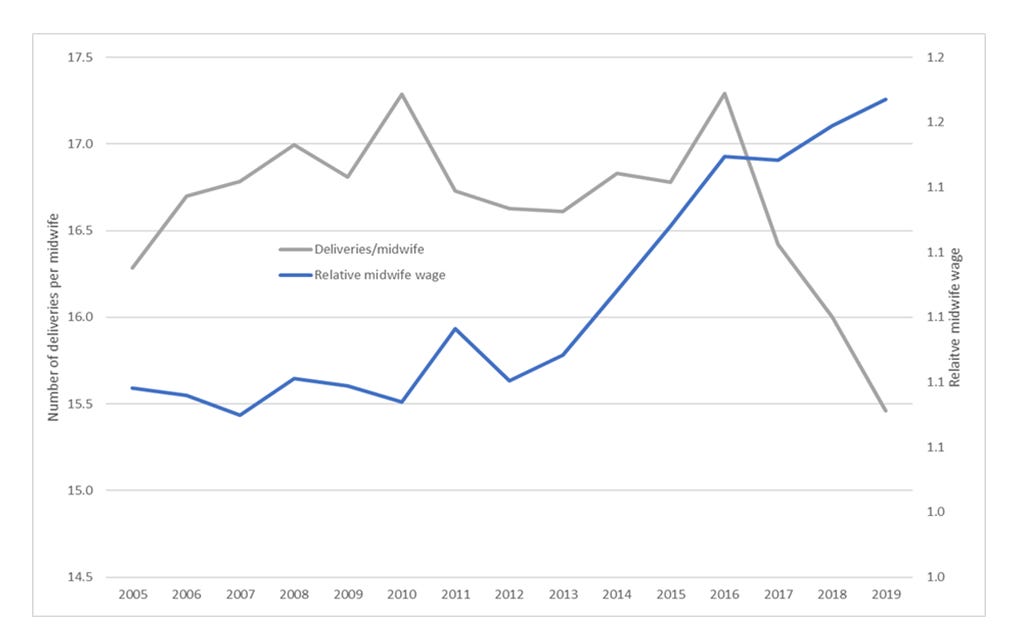What are Swedish midwifes doing?
Spoiler: Swedish midwifes are doing the wrong things. Despite what the media report about the midwifes’ work-life conditions, we have never had so many midwifes in Sweden.That may partly be explained by a favourable wage development. Midwifes’ wages relative all other professions have increased over the years.
Since the number of births have increased less than the number of midwifes, midwifes should be able to spend more time with delivering women and their infants. So why can’t they? Because they’re doing more and different tasks than before. Therefore, hiring more midwifes or raising their wages won’t help.
Swedish media is filled with stories about the midwife crisis. According to the reports, midwifes are overwhelmed and have barely time to for the midwifery. They run from one delivery room to another. According to especially the midwifes in the Stockholm region, the unbearable situation at work, endangers the health and security of delivering women and their infants.
The midwifes tell us that this development has been going on for years. Working as a midwife has been increasingly stressful at the same time as their wages have fallen behind. Accordingly, it is allegedly difficult to attract new midwifes.
The number of deliveries per midwife has decreased over the years
What are the causes of this situation? We have never had so many midwifes as today. And Swedish women have access to more midwifes than other Scandinavian countries. In Denmark and Norway, there are 66 and 88 midwifes per 100 000 people. In Sweden, there are 127, twice as many as in Denmark. So, the number of midwifes in Sweden has been increasing over time.
But that is irrelevant if, over time, the number of midwifes doesn’t catch-up with the number of deliveries. The reported alarming situation might be explained by deliveries increasing faster than midwifes.
Data from the Swedish National Board of Health and Welfare, shows something different than what the media tells us. The number of midwifes increased more than the number of deliveries in Sweden between 2005 and 2019. The increasing wages relative people in all other professions could be a factor increasing the attractiveness of being a midwife despite the reported alarming working conditions, c.f. Figure 1.
Figure 1. The number of deliveries per midwife (left axis) and midwifes’ relative monthly wages (right axis) in Sweden 2005–2019.
Sources: Deliveries and midwifes. The Swedish National Board of Health and Welfare. https://www.socialstyrelsen.se/statistik-och-data/statistik/statistikdatabasen/ Wages. Statistics Sweden. https://www.statistikdatabasen.scb.se/pxweb/sv/ssd/START__AM__AM0110__AM0110A/LonYrkeRegion4A/ Note: The relative wage is calculated as the average monthly wage for midwifes relative the average monthly wage for all professions.
The decreasing number of deliveries per midwife ought to enable the midwifes to devote more time for the delivering women, not less. Especially in Stockholm where the number of midwifes increased twice as much as the number of deliveries between 2005 and 2019.
Figure 1 shows the development for Sweden in total. The statistics are also provided for counties. County data show that the number of midwifes increased more than the number of deliveries in 107 out of 21 counties between 2005 and 2019. Going further back from 1995 shows reveals that the number of midwifes per deliveries increased only in two counties.
Midwifes perform more tasks now and have less time for their core business
Developments of increasing relative wages and fewer deliveries per midwife over time sounds like the working conditions are improving. So, what’s the problem? As the author of this opinion letter explains (https://www.svd.se/barnmorskorna-ar-fler--men-har-inte-tid), the number of tasks that a midwife performs has increased over time. Midwifes perform more tasks both inside and outside of the delivery rooms. This can be a result of attempts to improve safety and health for delivering women and the infants. Midwifery is labour intensive so some improvements require more midwifes. For example, two midwifes, instead of one, now check the delivering women for ruptures and more deliveries, now than before, are started in advance in order to reduce mortality due to too long pregnancies.
Still, that doesn’t explain why so many more midwifes are needed than in other Scandinavian countries. Some tasks that are performed seem unnecessary or better performed by other medical professions. Examining and stitching up ruptures should always be done by doctors. Treating delivering women by acupuncture should not be done at all unless you also believe in voodoo. Swedish midwifes also perform a new number of tasks outside of the delivery rooms. They participate in In vitro fertilisation (IVF) examinations and treatments. It can also be questioned whether so many number of controls and check-ups of pregnant women are necessary as now are undertaken.
Solving the problem
Solving the problem should be easy. The number of tasks that midwifes perform needs to be reduced significantly. Midwifes must spend more time in the delivery room. Period.




